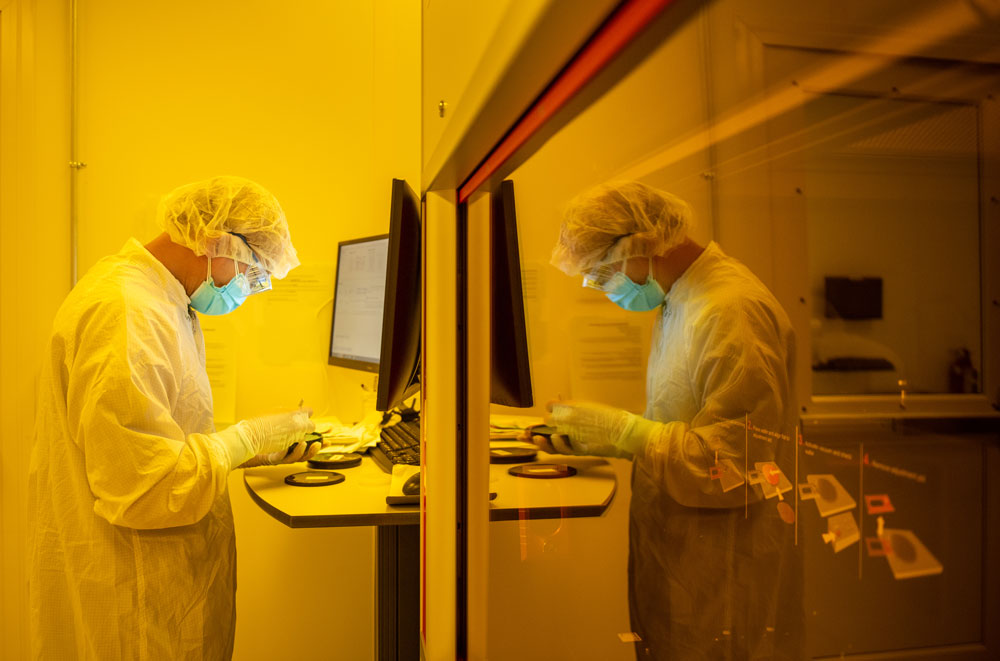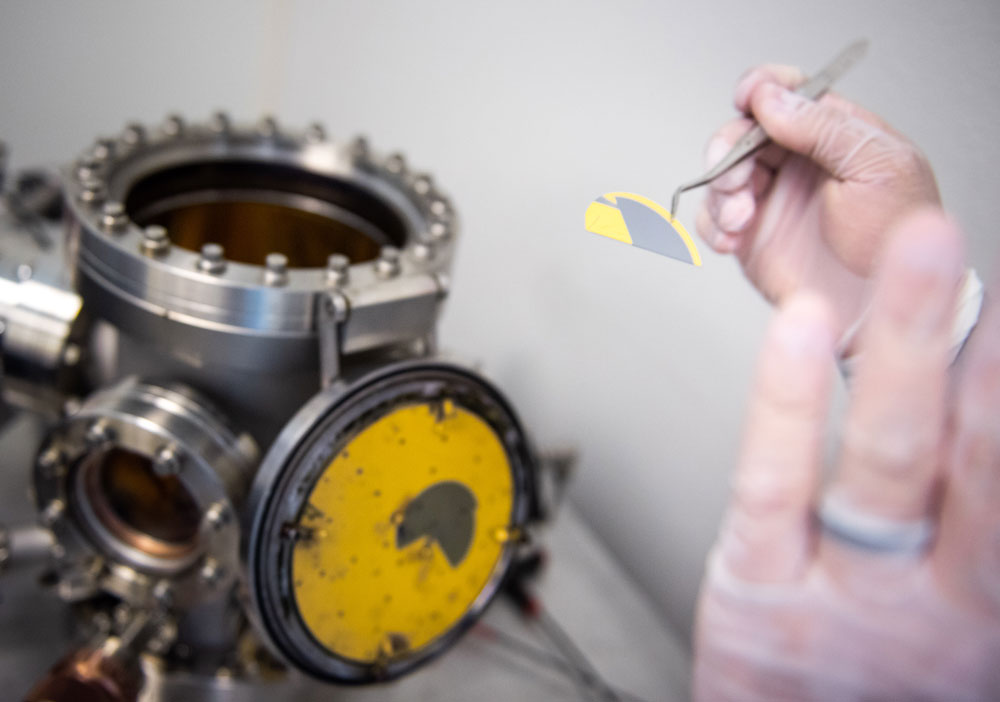
Born of curiosity-motivated discovery and driven by an urgent wartime need, the August 1945 atomic bomb explosions in Hiroshima and Nagasaki graphically illustrated the role of foundational science in the U.S. effort to bring World War II to an end. The world was both awed and horrified by the power and energy unleashed through nuclear physics. A new scientific era had begun.
In 1949, the Sandia Corp., which began as a Los Alamos Scientific Laboratory division, was responsible for the non-nuclear pieces of the nation’s nuclear weapons. By 1957, many at Sandia had realized that those non-nuclear pieces were fundamentally tied to a wide range of materials and natural phenomena best understood in the context of scientific principles.
At the forefront of this realization was a young manager and physicist Richard Claassen, who in March 1957 gave a presentation to Sandia’s AT&T/Bell Labs managers on plans for an organization dedicated to “fundamental research.” This “group of qualified scientific personnel,” Claassen said, would engage Sandia in several distinct but related disciplines, each overlapping with Sandia’s weapons work, specifically “solid-state physics, radiation effects, combustion processes, physical electronics, hydro-magnetics, high-temperature physics, theoretical mechanics and geophysics.” Claassen documented his remarks in a memo to Sandia leaders in May 1957.
In recognition of the 65th anniversary of Claassen’s remarks and memo, the Labs is launching a “Sandia Loves Science” campaign to honor the legacy of his words and Sandia’s rich history in advanced science, technology and engineering through articles, activities and events. The vision outlined by Claassen helped propel Sandia into an era of discovery that continues today.
The Claassen effect
The Labs’ leaders took note of Claassen’s contention that “in a mature organization, the research effort should be expended in advance of the development programs.” Claassen’s original presentation and the subsequent memo “are now viewed as the origin story for Sandia’s research,” said Susan Seestrom, Sandia’s associate labs director of advanced science and technology and chief research officer.
“It’s the reason Sandia now has strong research organizations exploring the fundamentals of science and engineering, making an impact not only on national security, but also on the international scientific community and global interest in the science of the possible,” Susan said.

Sandia’s interest in radiation effects was one of the earliest examples of such fundamental research. The Labs pursued a deeper understanding of radiation effects on electronic devices, which were beginning to be semiconductor-based rather than relying on vacuum tubes. Research in ion-solid interactions helped establish the fundamental materials physics of ion implantation, a process for altering the surface of materials to change its properties. The work was embodied in a then-widely used computer program called Transport of Ions in Matter. To this day, the publication about TRIM is one of Sandia’s most often cited and influential articles. In 1990, Sandia researcher Tom Picraux received the prestigious DOE Office of Science E.O. Lawrence award “for developments in ion-channeling and related ion-beam techniques for materials characterization, leading to new microscopic understanding of materials.”
Another early and ongoing example of Sandia’s impact is fundamental research in combustion science. In the 1970s, researchers recognized the advanced computational and laser diagnostic tools that the Labs pioneered for weapons development could be employed to probe the complexity of combustion. Sandia’s Combustion Research Facility became a leading force in understanding the coupled chemistry and turbulent mixing that underlies combustion processes. Direct and detailed measurement of combustion, including in operating engines, was coupled with fundamental discovery in chemical reactivity and turbulent transport. CRF accomplishments were recognized, for example, with the elections of engineers Jim Miller and Jackie Chen to the National Academy of Engineering. Far-reaching Sandia-developed tools like the Chemical Kinetics, or CHEMKIN, program for calculating combustion chemistry helped bring these discoveries to designers of cleaner and more efficient devices.
The Labs’ fundamental research in compound semiconductors laid the foundation for strained-layer devices, for which Sandia physicist Gordon Osbourn received the 1985 E.O. Lawrence award, which noted his work “for stimulating the new field of strained-layer super lattices by making the first theoretical calculations predicting their unique electrical and optical properties.”
“Claassen’s objectives for a fundamental research organization still guide us today even though the nature of national and global security work has changed. As engineers, we can do a better job of collaborating with scientists earlier in the process—in research, advice, and design before there is ever a surprise problem.”
—Sandia Labs Director James Peery
Sandia has since pioneered many such devices with significant impact not only on weapons design but also important other applications. Innovations in solid-state lighting are increasing the energy efficiency of general illumination worldwide, and innovations in ultra-wide-bandgap semiconductors will influence future power electronics for grid modernization.
Sandia also has extended its fundamental research into the area of quantum information science. With roots in the early 2000s, researchers embarked on a Laboratory Directed Research and Development Grand Challenge, Quantum Information Science and Technology. Still in its early years, quantum research has a wide range of national security applications, not to mention the promise of revolutionizing computation.
“Sandia has been strategic in adding new areas like high-performance computing, computational science, quantum information science and climate science,” said Labs Director James Peery, commenting on Claassen’s words. “We have looked at what’s on the horizon and made investments through LDRD and other vehicles to bring in the scientists and engineers. We’ve had a true impact, not only in the scientific community, but also in the national security community.”
Discovering the future
The fundamental research Sandia engages in will continue to impact national security and society.
“It’s easy to get distracted by the urgent nature of our deliveries in nuclear deterrence and national security work and lose sight of the deep scientific understanding and the deep thinking that comes from having a vigorous fundamental science program,” said Associate Labs Director Andy McIlroy. “That is what allows us to address problems that others in the scientific and engineering community think are impossible to solve.”
Claassen raised challenges associated with foundational research that remain today. Claassen said the best research and development work happens inside a corporate culture and organizational structure that encourages and supports discovery research and the scientists who desire to pursue it. Claassen proposed a research organization because he saw fertile ground for growing fundamental science and scientists at Sandia.
“Claassen’s ideas bear repeating and still apply even if we extend them from the weapons work of the late 1950s to the many other national security areas we work on today,” said Deputy Chief Research Officer Basil Hassan.
“Claassen recognized then, and it is still true now, that success comes from the close connections between those engaged in early-stage discovery research and engineering solutions. We tend to see research to development to application as a linear process, but Sandia has demonstrated success in many areas, including impacts to the national hypersonics and energy programs, by ensuring this process is circular. By learning how to translate that discovery to engineering applications, we then learn how to better drive discovery research by those areas inspired by our broad national security mission,” Basil said.
Sandia’s people, research foundations, capabilities and programs not only serve national security but also contribute to the nation’s technoscientific health. The Labs’ seven research foundations — bioscience, computing and information science, earth science, engineering science, materials science, nanodevices and microsystems, and radiation, electrical and high energy density science — align with mission needs.
“Claassen’s objectives for a fundamental research organization still guide us today even though the nature of national and global security work has changed,” James said. “As engineers, we can do a better job of collaborating with scientists earlier in the process — in research, advice and design before there is ever a surprise problem.”
The next generation
James sees research opportunities as a great recruiting tool.
“We do great science here, and we often don’t know where that science is going to (take us),” he said. “You may be working on research in one area of national security and discover that what you’re working on is applicable, say, to climate security. Or vice versa. Multiuse research is one of the really fun parts of the science that we do here. You never really know at the beginning where it might lead.”

For example, James said, “In the mid-1990s, one individual started an LDRD project on optimization techniques. For probably five years, we didn’t know exactly where it was headed. Then came this huge push for modeling and simulation, not only optimization but also uncertainty quantification, sensitivity analysis. And now, it’s probably one of LDRD’s biggest successes. There are countless examples like that at the Labs.”
Recognizing that the Labs’ work is expanding into new areas that may have seemed like science fiction to Claassen, such as artificial intelligence, quantum computing and the rise of biology as a predictive science, James encourages the workforce to “be curious when new hires talk about new scientific tools or new approaches to doing engineering, which they bring into our laboratory environments. And we need to extend that interest to all levels of management who are involved in addressing the challenges.”
"This is an exciting time for fundamental research, curiosity and discovery at Sandia," Susan said. Discovery research often leads to unexpected breakthroughs and can nurture and sustain an inquisitive and creative workforce, one of whom could write the next Claassen Memo.
“As experimentalists, we are involved in rapid cycles of learning,” she said. The Advanced Science and Technology division, Sandia’s primary research organization, “exists to solve the foundational science, technology and engineering questions of today and tomorrow.”